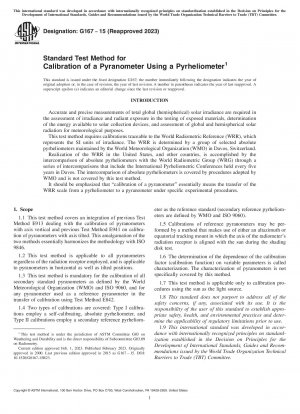ASTM G167-15(2023)
Standard Test Method for Calibration of a Pyranometer Using a Pyrheliometer
- Standard No.
- ASTM G167-15(2023)
- Release Date
- 2023
- Published By
- American Society for Testing and Materials (ASTM)
- Latest
- ASTM G167-15(2023)
- Scope
- 1.1 This test method covers an integration of previous Test Method E913 dealing with the calibration of pyranometers with axis vertical and previous Test Method E941 on calibration of pyranometers with axis tilted. This amalgamation of the two methods essentially harmonizes the methodology with ISO 9846. 1.2 This test method is applicable to all pyranometers regardless of the radiation receptor employed, and is applicable to pyranometers in horizontal as well as tilted positions. 1.3 This test method is mandatory for the calibration of all secondary standard pyranometers as defined by the World Meteorological Organization (WMO) and ISO 9060, and for any pyranometer used as a reference pyranometer in the transfer of calibration using Test Method E842. 1.4 Two types of calibrations are covered: Type I calibrations employ a self-calibrating, absolute pyrheliometer, and Type II calibrations employ a secondary reference pyrheliometer as the reference standard (secondary reference pyrheliometers are defined by WMO and ISO 9060). 1.5 Calibrations of reference pyranometers may be performed by a method that makes use of either an altazimuth or equatorial tracking mount in which the axis of the radiometer’s radiation receptor is aligned with the sun during the shading disk test. 1.6 The determination of the dependence of the calibration factor (calibration function) on variable parameters is called characterization. The characterization of pyranometers is not specifically covered by this method. 1.7 This test method is applicable only to calibration procedures using the sun as the light source. 1.8 This standard does not purport to address all of the safety concerns, if any, associated with its use. It is the responsibility of the user of this standard to establish appropriate safety, health, and environmental practices and determine the applicability of regulatory limitations prior to use. 1.9 This international standard was developed in accordance with internationally recognized principles on standardization established in the Decision on Principles for the Development of International Standards, Guides and Recommendations issued by the World Trade Organization Technical Barriers to Trade (TBT) Committee. 1 This test method is under the jurisdiction of ASTM Committee G03 on Weathering and Durability and is the direct responsibility of Subcommittee G03.09 on Radiometry. Current edition approved Feb. 1, 2023. Published February 2023. Originally approved in 2000. Last previous edition approved in 2015 as G167 – 15. DOI: 10.1520/G0167-15R23. Copyright © ASTM International, 100 Barr Harbor Drive, PO Box C700, West Conshohocken, PA 19428-2959. United States This international standard was developed in accordance with internationally recognized principles on standardization established in the Decision on Principles for the Development of International Standards, Guides and Recommendations issued by the World Trade Organization Technical Barriers to Trade (TBT) Committee. 1 2. Referenced Documents
ASTM G167-15(2023) Referenced Document
- ASTM E772 Standard Terminology Relating to Solar Energy Conversion
- ASTM E824 Standard Test Method for Transfer of Calibration From Reference to Field Radiometers
ASTM G167-15(2023) history
- 2023 ASTM G167-15(2023) Standard Test Method for Calibration of a Pyranometer Using a Pyrheliometer
- 2015 ASTM G167-15 Standard Test Method for Calibration of a Pyranometer Using a Pyrheliometer
- 2005 ASTM G167-05(2010) Standard Test Method for Calibration of a Pyranometer Using a Pyrheliometer
- 2005 ASTM G167-05 Standard Test Method for Calibration of a Pyranometer Using a Pyrheliometer
- 2000 ASTM G167-00 Standard Test Method for Calibration of a Pyranometer Using a Pyrheliometer
